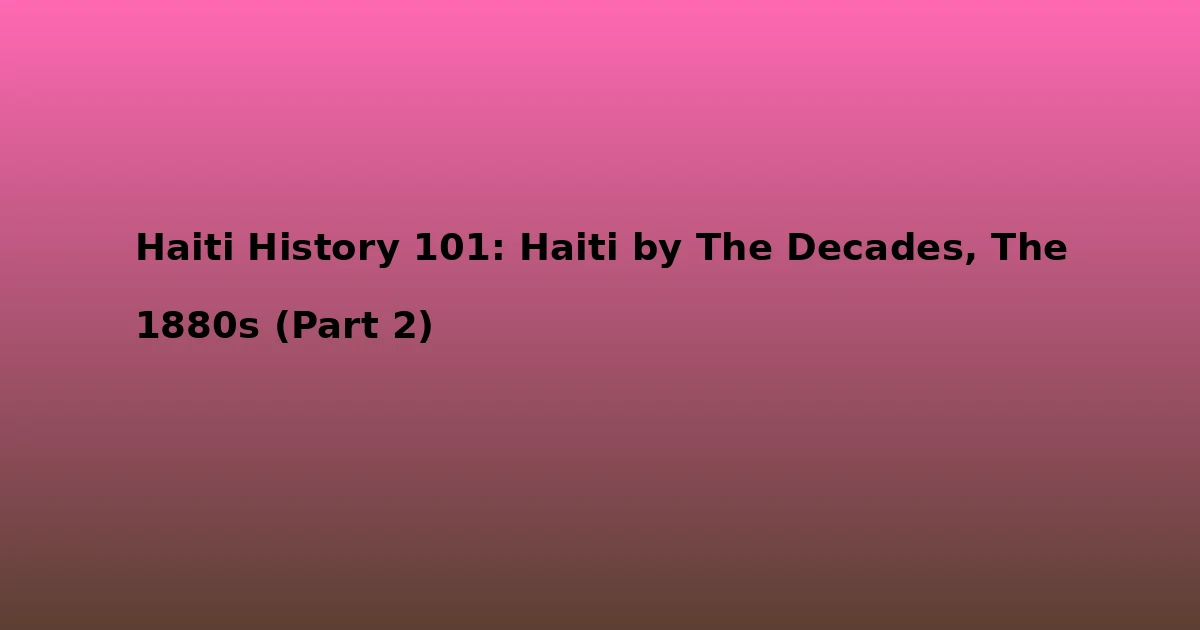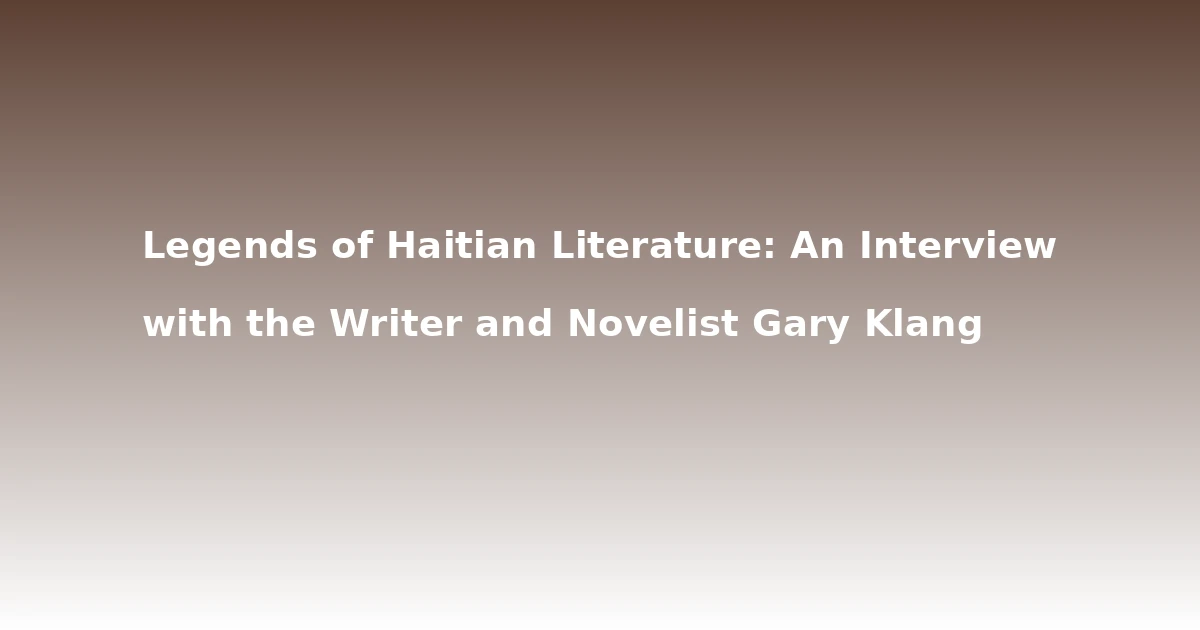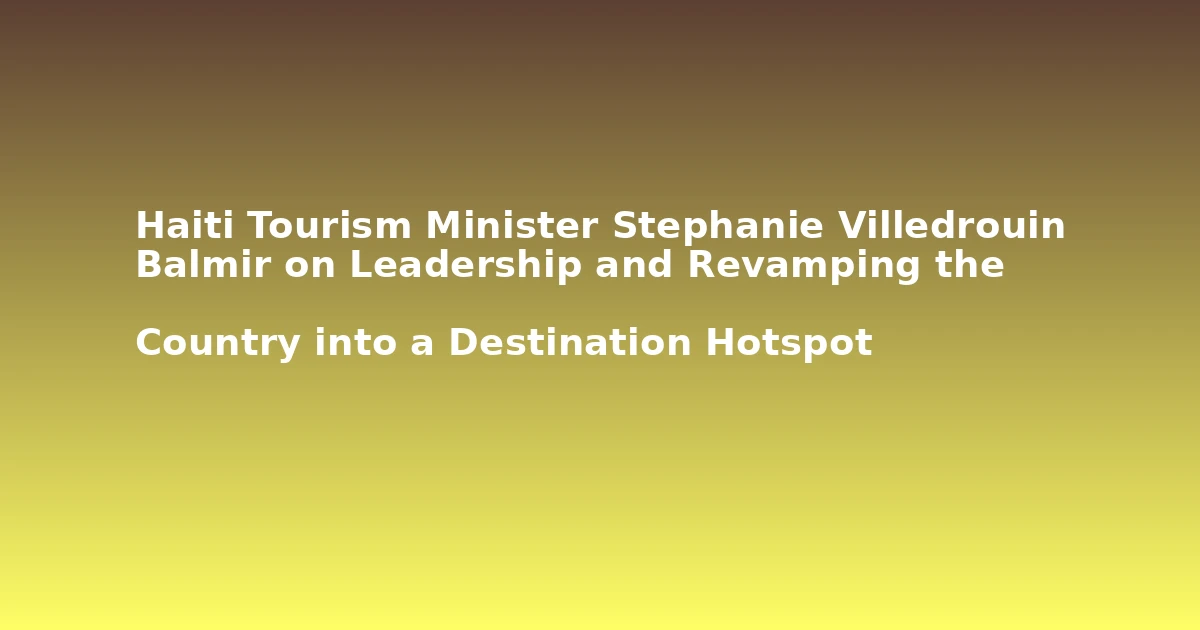Who here thinks that Haiti is a great tourist destination, and one that will regain its footing at the top of the best tourism destinations in the world? Well, Paul Clammer for one. Clammer is the author of , published this month in the United States, after enjoying a release last November in England.
In recent years—heck—over the last couple of decades, Haiti has been virtually ignored in a great many tourism books, and sometimes when it was mentioned by some, it was to include it on a list of places to avoid.
Clammer is here to change all that with his new guidebook, and will hopefully begin a new trend where guides to Haiti (and mentions of Haiti in guidebooks about the Caribbean) are concerned.
Haiti Bradt Travel Guide is not Clammer’s first encounter with Haiti. In 2011, the travel guru was commissioned along with two other travel writers to create Dominican Republic and Haiti in the Lonely Planet’s Country Travel Guide series. This new guide, of course, is devoted entirely to the Pearl of the Antilles.
Clammer discussed writing the book, , his favorite spots, and what writing the first guidebook in English about Haiti—in goodness knows how many years—taught him about the country!
Q & A
How did you get into this whole travel writing thing?
Well, in a previous life I was a molecular biologist, so my career trajectory hasn’t exactly been straightforward. Taking a break from the lab, I accidentally fell into the adventure , first selling safaris and trekking trips, and then working as a tour guide. I was also doing a lot of traveling independently, and ended up writing a travel website about Afghanistan – I was actually in Kabul about a fortnight before 9/11, and had some interesting experiences meeting the Taliban.
In 2003, I was approached by Lonely Planet guides to write about that country for them, so I got labeled as the guy who doesn’t mind roughing it too much. Nigeria, Pakistan, Sudan – you name it, it seems that’s where I’ve ended up writing about! But whenever I’ve been in Haiti in a beach bar with a rum sour, watching the sun, I always think ‘Yes, today I’ve really got the tough gig…’
Some time ago, you helped write a dual country guide, featuring Haiti and The Dominican Republic. What made you decide to devote an entire book to Haiti this time around?
The first time I came to Haiti to write, I put my hand up for it because no one else wanted to do it. But when I got there, I was just swept away by it.
That’s not an uncommon reaction, is it? It always felt a little odd to have a guidebook split between those two countries. It’s a geographical accident, but there’s not a huge amount of overlap between people visiting the Dominican Republic and Haiti.
People go to each for completely different reasons. The more time I spent in Haiti, the more I knew there was to tell, and the only way to do that was to write a complete book purely about Haiti. When I pitched the idea to Bradt, we realized that there hasn’t actually been an English guidebook dedicated to Haiti since the 1980s! I’m really proud that we’ve been able to correct that.
You lived in Haiti for nine months. Was Haiti everything you thought it would be prior to your arrival there? Anything in particular surprise you?
You might be better off asking my partner that, as I persuaded her to come with me and she’d never been to Haiti before!
Of course, there’s a big difference between visiting somewhere for a few weeks and staying long enough to actually buy furniture. So there was a lot of getting intimate with things like the patchy electricity supply, or the subtleties of the changing seasons – not just the weather, but when you’d see new mangoes appearing in the market, bands releasing their Carnival songs or the guys on the streets starting to sell their Fanal Christmas decorations. I really enjoyed all those small details, and hopefully that’s informed the way I wrote the book.
What is your favorite spot in Haiti?
I have to choose just one? I think the big revelation for me was Môle Saint-Nicholas. It’s out of the way and not so many people get there, but it’s incredibly beautiful.
It has gorgeous beaches with really healthy coral, and lots of old forts from the French and Revolutionary periods. The municipality is very organized too, and they’re trying to attract tourists –last year they even had billboards up in Port-au-Prince. And they haven’t waited for big developers to come in, but they’re doing it all themselves, producing a local tourist map, listing guides who can take you on nature walks or boat trips.
The forts even have information boards – you don’t even see that at the Citadelle. Everything seems geared to the local community, which is really inspiring. I’d love to see more of that.
Haiti’s cuisine always manages to enthrall. Did it enthrall you? What dishes did you salivate over?
It seems a crazy thing to admit, but I was never really a big fan of avocados before I went to Haiti.
But they’re just the best anywhere aren’t they. I miss them enormously. And griyo too. I’m a huge fan of griyo – and fritay in general to be honest, with a big helping of pikliz on the side.
Were you like, afraid for your life at any time? Sarcasm, sarcasm!
That’s the one question everyone gets asked when they go to Haiti, right? It gets a bit tiring to be honest, all those lazy clichés about the place that don’t seem to have moved on much since Graham Green wrote The Comedians. But stuff that actually makes me afraid?
Not so much, unless you count the big intercity buses scare. They scare the hell out of me – the drivers are completely crazy. I try not to go on those too much if I can avoid them.
Before the earthquake of 2010, before the AIDS epidemic of the 1980s, the embargo of the 1990s, and the Papa Doc era of the latter 1960s, Haiti was a tourist mecca. What do you think can be done to bring it back to that level?
If you look at tourist books from the late 1940s and 50s – the Estimé and Magloire periods, Haiti was a pretty fashionable destination. All those dance clubs and casinos!
Caribbean tourism was in its infancy, but Haiti was in the vanguard. Of course, all Haiti’s neighbors have since developed things so much further, so it’s not surprising that the government looks at the DR or Jamaica and wants of that. But I think in many ways it’s too late for that, and I don’t think Haiti should necessarily be trying to compete that way any way.
Haiti actually has lots of other strengths – historical sites, culture, art, Vodun and so on. Haiti has plenty of beautiful beaches, but tourism shouldn’t be about shuttering people away in resorts. They absolutely have to get out and see the country. Not only will they learn more and have more fun, they’ll also spread the economic benefits of their visit further.
I think its incumbent on any tourism development plan that it has to benefit the maximum number of people, not just be numbers on the spreadsheet. That’s doubly important when you see the tax breaks being offered to foreign tourism investors to go to Haiti. I’d like to see a discussion about the economics of tourism from a development point of view and how it’s going to help Haiti meet its Millennium Development Goals. Tourism is only going to work if it’s a rising tide lifting that lifts all boats.
The other big issue is infrastructure. The topic of the big new hotels in Port-au-Prince has been written about a lot in the past year and I’ve visited I’ve visited enough hotels to know that there’s a chronic shortage of both beds and quality. But that’s only part of the infrastructure mix.
To go back to my example of Môle Saint-Nicholas, there’s actually a brand new hotel there that’s just been built by a diaspora family who wanted to invest money back in their hometown, which is great. But with that, and the other things I talked about, the ultimate breaks on developing tourism are hard things like the fact that the town is a nightmare to access because the road is so bad, the fact that there’s an inadequate water supply, electricity and so on. Those are the things that will make the ultimate difference. Sorting those issues will improve the situation of the residents in general, and then hopefully tourism can then come along in its wake.
There’s this saying that once you have been to Haiti once, it has this charm that will pull you back and back again. When are you planning your next visit?
I’m going to be back in Haiti at the end of February. It’ll only be for a couple of weeks, but I can’t wait!
What tips do you have for first-time visitors to Haiti?
Above all things, don’t believe . If you didn’t know anything different, it could be easy to assume that the entire country is nothing but earthquake rubble, or that you’ll be kidnapped within minutes of arriving in Port-au-Prince. It was great to see the Haitian government really pushing back on the recent travel advisory from the US government.
Of course, Haiti isn’t without problems, and it would have been remiss of me not to talk about that in the guidebook, but by the same token, you never get told how beautiful Haiti is. And it is, staggeringly so. So definitely be prepared for that.
We bet that you did some shopping in Haiti while you there. What have been some of your best buys?
Yes, I may have bought one or two things over the course of my trips… I think the favorite thing from this long stay in Haiti was the giant papier-mâché chicken that we bought during Jacmel Carnival weekend – it’s painted bright red and covered with flowers, and is both brilliant and crazy. I think that next on my wish-list has to be a really good drapo (Vodun flag). Because I’ve been visiting for a few years now, friends and family have all had their souvenirs now, so these days I prefer to bring back things like Barbancourt rum, or some Rebo coffee – proper tastes of Haiti.
Haiti tourism is on the move! Be sure to read other articles in this series.
Last Updated on December 4, 2025 by kreyolicious



